 Backend Development
Backend Development PHP Tutorial
PHP Tutorial How to implement error handling and exception handling strategies in PHP development
How to implement error handling and exception handling strategies in PHP developmentHow to implement error handling and exception handling strategies in PHP development
Introduction:
In Web development, errors and exceptions are inevitable. When the code runs incorrectly or does not meet expectations, proper error handling and exception handling will greatly improve the reliability and maintainability of the code. This article will introduce how to implement error handling and exception handling strategies in PHP development.
1. Error handling
PHP provides some error handling functions and configuration options for handling different types of errors:
- Setting the error level:
In PHP, you can set the error level by using error reporting functions in your code or by modifying the php.ini file. Commonly used error levels include E_ALL, E_ERROR, E_WARNING, etc. E_ALL will display all errors, E_ERROR will display only serious errors, and E_WARNING will display only warning messages. - Display of error messages:
In the development environment, you can turn on the display of error messages, which will help you find and solve errors in a timely manner. Error messages can be displayed in the browser by setting the display_errors option in the php.ini file to On. In a production environment, in order to protect the security of the system, the display_errors option should usually be set to Off to avoid exposing possible error information to the outside world. - Error log recording:
In addition to displaying error information on the browser, you can also write error information to a log file to facilitate troubleshooting later. You can specify the location and file name of the error log by setting the error_log option in the php.ini file. Saving the error log to a specified file can avoid exposing error information in the browser and facilitate management and analysis.
2. Exception handling
In addition to regular errors, PHP also supports an exception handling mechanism to handle abnormal situations that occur during the running of the program. An exception is an object that handles and delivers exception information in an object-oriented manner.
- Definition of exception classes:
In PHP, we can customize exception classes to handle different exception situations. Custom exception classes must inherit from the Exception class. By customizing exception classes, exception types and handling methods can be defined according to specific business needs, improving the readability and maintainability of the code. - Exception handling syntax:
In PHP, exceptions are handled through the try-catch-finally syntax block. The try block contains code that may throw exceptions, the catch block is used to catch and handle thrown exceptions, and the finally block is used to execute some code that needs to be executed regardless of whether there is an exception. - Exception delivery and exception chain:
In PHP, exceptions can be thrown through the throw statement and captured through the catch statement. After the exception is caught, if the exception is not handled in the catch block, or if the exception continues to be thrown after handling the exception, the exception will be passed to the upper layer of code until it is handled. The formation of the exception chain makes the program's exception handling more flexible and controllable. - Exception handling for automatic loading:
In PHP development, automatic loading functions (such as __autoload or spl_autoload_register) are usually used to load class files. If the corresponding class file cannot be found during the automatic loading process, the developer can be prompted by throwing a custom class not found exception (such as ClassNotFoundException).
Conclusion:
Error handling and exception handling are important technical means in PHP development, which can improve the reliability and maintainability of the code. By appropriately setting the error level, displaying error information, and recording error logs, developers can help developers discover and solve problems in a timely manner. By properly defining and handling exceptions, you can provide a friendlier application and user experience. In daily development, we should adopt appropriate error handling and exception handling strategies according to specific situations and needs to improve code quality and project stability.
The above is the detailed content of How to implement error handling and exception handling strategies in PHP development. For more information, please follow other related articles on the PHP Chinese website!
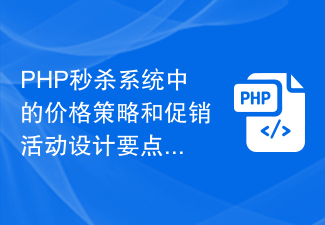 PHP秒杀系统中的价格策略和促销活动设计要点Sep 19, 2023 pm 02:18 PM
PHP秒杀系统中的价格策略和促销活动设计要点Sep 19, 2023 pm 02:18 PMPHP秒杀系统中的价格策略和促销活动设计要点在一个秒杀系统中,价格策略和促销活动设计是非常重要的一部分。合理的价格策略和精心设计的促销活动可以吸引用户参与秒杀活动,提升系统的用户体验和盈利能力。下面将详细介绍PHP秒杀系统中的价格策略和促销活动设计要点,并提供具体的代码示例。一、价格策略设计要点确定基准价格:在秒杀系统中,基准价格是指商品正常销售时的价格。在
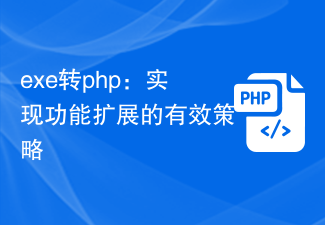 exe转php:实现功能扩展的有效策略Mar 04, 2024 pm 09:36 PM
exe转php:实现功能扩展的有效策略Mar 04, 2024 pm 09:36 PMEXE转PHP:实现功能扩展的有效策略随着互联网的发展,越来越多的应用程序开始向web化迁移,以实现更大范围的用户访问和更便捷的操作。在这个过程中,将原本以EXE(执行文件)方式运行的功能转化为PHP脚本的需求也在逐渐增加。本文将探讨如何将EXE转换为PHP来实现功能扩展,同时给出具体的代码示例。为什么将EXE转换为PHP跨平台性:PHP是一种跨平台的语言
 Astar质押原理、收益拆解、空投项目及策略 & 操作保姆级攻略Jun 25, 2024 pm 07:09 PM
Astar质押原理、收益拆解、空投项目及策略 & 操作保姆级攻略Jun 25, 2024 pm 07:09 PM目录Astar Dapp 质押原理质押收益 拆解潜在空投项目:AlgemNeurolancheHealthreeAstar Degens DAOVeryLongSwap 质押策略 & 操作“AstarDapp质押”今年初已升级至V3版本,对质押收益规则做了不少调整。目前首个质押周期已结束,第二质押周期的“投票”子周期刚开始。要获取“额外奖励”收益,需把握此关键阶段(预计持续至6月26日,现余不到5天)。我将细致拆解Astar质押收益,
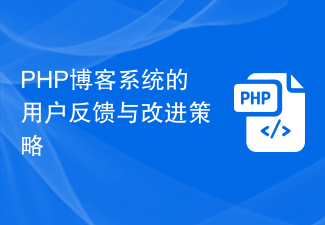 PHP博客系统的用户反馈与改进策略Aug 09, 2023 am 10:58 AM
PHP博客系统的用户反馈与改进策略Aug 09, 2023 am 10:58 AMPHP博客系统的用户反馈与改进策略引言:随着互联网的普及和发展,博客已成为人们分享自己知识和经验的重要途径。为了满足用户的需求,开发一个稳定、易用、功能全面的博客系统至关重要。然而,随着软件的不断迭代,用户的反馈和建议变得尤为重要,因为它们可以帮助我们发现系统的问题并改进系统。本文将讨论PHP博客系统的用户反馈与改进策略,并通过代码示例阐述改进的步骤和方法。
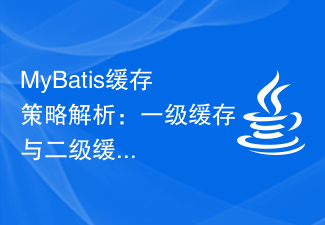 MyBatis缓存策略解析:一级缓存与二级缓存的最佳实践Feb 21, 2024 pm 05:51 PM
MyBatis缓存策略解析:一级缓存与二级缓存的最佳实践Feb 21, 2024 pm 05:51 PMMyBatis缓存策略解析:一级缓存与二级缓存的最佳实践在使用MyBatis进行开发时,我们经常需要考虑缓存策略的选择。MyBatis中的缓存主要分为一级缓存和二级缓存两种。一级缓存是SqlSession级别的缓存,而二级缓存是Mapper级别的缓存。在实际应用中,合理地使用这两种缓存是提高系统性能的重要手段。本文将通过具体的代码示例来解析MyBatis中一
 CentOS7软件的安装步骤和策略全解析Jan 04, 2024 am 09:40 AM
CentOS7软件的安装步骤和策略全解析Jan 04, 2024 am 09:40 AM2010年开始正式接触Linux,入门发行版是Ubuntu10.10,后来过渡到Ubunu11.04,这其中也尝试了很多其他主流的发行版。进入实验室之后,开始用CentOS5,然后是CentOS6,现在进化到CentOS7。使用了四年的Linux,前三年都是在瞎折腾,浪费了不少时间,也得到了不少经验与教训。现在可能是真的老了,已经不愿意折腾了,只希望配置好一个系统之后,就一直使用下去。为什么要写/读这一篇使用Linux尤其是CentOS会遇到一些坑,或是一些有洁癖的人不能忍的事情:官方源中的软件
 使用基于策略的数据结构进行逆序计数Sep 02, 2023 pm 11:45 PM
使用基于策略的数据结构进行逆序计数Sep 02, 2023 pm 11:45 PM我们将使用g++头文件在C++编译器中编译代码。g++是一个基于Linux的头文件,用于在C++中编译基于策略的数据结构的代码。基于策略的数据结构是用于代码的高性能和灵活性的结构。由于这些数据结构非常丰富,我们可以将它们用于许多功能,例如搜索元素的索引、将元素插入到索引位置、从索引范围中删除元素等。Example的中文翻译为:示例让我们举一个反转计数的例子-假设构建树的内部遍历是1,2,3,4,5,当我们遍历以反转它时,树的形式变为5,4,3,2,1.让我们将以下树结构作为输入<5,4,3
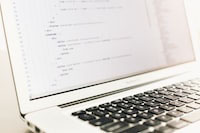 Java Map揭秘:实现数据快速存取的技巧和策略Feb 19, 2024 pm 06:21 PM
Java Map揭秘:实现数据快速存取的技巧和策略Feb 19, 2024 pm 06:21 PMJavaMap是一个基于键值对的数据结构,它允许开发人员快速存储和检索数据。Map的键可以是任何对象,而值可以是任何类型的数据。Map中每个键最多只能与一个值相关联,如果对同一个键设置多个值,则只会保留最后设置的值。Map有两种主要实现:HashMap:使用散列表来存储键值对。HashMap的性能取决于散列表的实现方式,在大多数情况下,HashMap的性能优于TreeMap。TreeMap:使用红黑树来存储键值对。TreeMap的性能与HashMap相似,但是在某些情况下,TreeMap的性能可


Hot AI Tools

Undresser.AI Undress
AI-powered app for creating realistic nude photos

AI Clothes Remover
Online AI tool for removing clothes from photos.

Undress AI Tool
Undress images for free

Clothoff.io
AI clothes remover

AI Hentai Generator
Generate AI Hentai for free.

Hot Article

Hot Tools

mPDF
mPDF is a PHP library that can generate PDF files from UTF-8 encoded HTML. The original author, Ian Back, wrote mPDF to output PDF files "on the fly" from his website and handle different languages. It is slower than original scripts like HTML2FPDF and produces larger files when using Unicode fonts, but supports CSS styles etc. and has a lot of enhancements. Supports almost all languages, including RTL (Arabic and Hebrew) and CJK (Chinese, Japanese and Korean). Supports nested block-level elements (such as P, DIV),

Dreamweaver CS6
Visual web development tools

SublimeText3 Mac version
God-level code editing software (SublimeText3)

SublimeText3 Linux new version
SublimeText3 Linux latest version

SublimeText3 English version
Recommended: Win version, supports code prompts!





